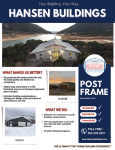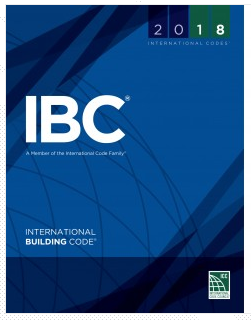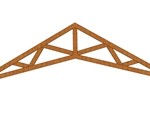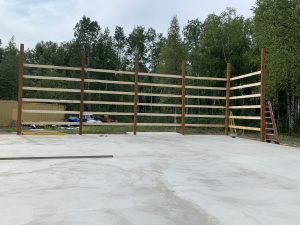This Wednesday the Pole Barn Guru answers reader questions about the design of a small living space with everything together in one room, whether or not one can use existing posts that are still standing in the aftermath of Hurricane Helene, and a reader asks why we don’t post prices of past projects on our website.
 DEAR POLE BARN GURU: I want a 1 room with very small sitting area, a bed area a kitchen very small and a walk in shower toilet and water basin all together in one room. LISA in ALMA
DEAR POLE BARN GURU: I want a 1 room with very small sitting area, a bed area a kitchen very small and a walk in shower toilet and water basin all together in one room. LISA in ALMA
DEAR LISA: Our Design Team can certainly craft a building solution to best meet your wants and needs. Please reach out to Megan on her direct line: 605.432.8987 on Monday to discuss further.
DEAR POLE BARN GURU: I lost my house in the Florida big bend due to Storm Surge from Helene. My house was on 8×8 posts on 8 foot centers. The house is gone but posts are still standing. They are 10 feet high. My question can I install the pole barn on my existing posts. The dimensions are basically 32′ by 32′ and again are 10 feet high. If so what do I need to do to give it as much strength as possible. Thanks, RICHARD in PERRY
 DEAR RICHARD: Sorry for your loss of your home, has to have been devastating. Could and should are our operative words here. I first experienced stilt houses when visiting Kitty Hawk (https://www.hansenpolebuildings.com/2014/11/kitty-hawk/). As you have experienced first-hand what happens when a “hinge” point is created between columns and home above, even though you could use your existing columns, I would strongly encourage their being removed and replaced with columns long enough to run full height up to eave line. If your now gone home had been engineered this way, it is highly unlikely we would be having this exchange today. Our Design Team can work with you to craft a new home, able to withstand even storms like Helene.
DEAR RICHARD: Sorry for your loss of your home, has to have been devastating. Could and should are our operative words here. I first experienced stilt houses when visiting Kitty Hawk (https://www.hansenpolebuildings.com/2014/11/kitty-hawk/). As you have experienced first-hand what happens when a “hinge” point is created between columns and home above, even though you could use your existing columns, I would strongly encourage their being removed and replaced with columns long enough to run full height up to eave line. If your now gone home had been engineered this way, it is highly unlikely we would be having this exchange today. Our Design Team can work with you to craft a new home, able to withstand even storms like Helene.
![]() DEAR POLE BARN GURU: Looking at your project # and photos, why can’t you have prices of how much these costed customers/projected. I don’t really care to speak to someone as I’m preparing my first pole barn project but I want to get an idea of what I want to install on our property. Very frustrating and I’ve found one builder who proves are listed making my purchase 10x easier to plan for… RICHARD in SPOKANE
DEAR POLE BARN GURU: Looking at your project # and photos, why can’t you have prices of how much these costed customers/projected. I don’t really care to speak to someone as I’m preparing my first pole barn project but I want to get an idea of what I want to install on our property. Very frustrating and I’ve found one builder who proves are listed making my purchase 10x easier to plan for… RICHARD in SPOKANE
DEAR RICHARD: Our intent is certainly not to frustrate. We could post what our clients paid at time they ordered, however those prices would only be reflective of material costs at one particular point in time. During COVID prices escalated dramatically and have since eased, so brief snippets from before or during would not give you an accurate price. We also provide buildings in all 50 states – so design loads can vary greatly. We have engineered for design wind speeds in excess of 200mph, buildings with full exposure to winds off large bodies of water and snow loads over 400psf. Outside of all of these, since we opened our wholesale lumber business and prefabricated wood truss facility this year, our materials costs have dropped exponentially, however shipping to Iowa is going to be less costly than shipping to Washington (as an example).
Our Building Design team will happily provide you with an exact and current price for your location. All we need is for you to please email our Project number, site address and best contact number to our Design Studio Manager Caleb@HansenPoleBuildings.com 1.866.200.9657 Thank you.
 DEAR POLE BARN GURU: What is your best guess at price per square foot range materials and labor to build a Hanson Pole Building these days? STEVE in MAPLE PLAIN
DEAR POLE BARN GURU: What is your best guess at price per square foot range materials and labor to build a Hanson Pole Building these days? STEVE in MAPLE PLAIN DEAR JOHN: These trusses may or may not be adequate for your needs, depending upon loads and spacing they were designed for.
DEAR JOHN: These trusses may or may not be adequate for your needs, depending upon loads and spacing they were designed for. DEAR DAN: You would be incorrect. Poles (actually columns) are inanimate objects and can be spaced at whatever distance their size and grade is capable of supporting using sound engineering practice. Our engineers recently designed a building for one of our clients with columns every 18′ and many years ago, I did one with columns spaced 24 feet on center. In most instances (depending upon climactic loads and door/window locations) columns every 12 feet are most economical.
DEAR DAN: You would be incorrect. Poles (actually columns) are inanimate objects and can be spaced at whatever distance their size and grade is capable of supporting using sound engineering practice. Our engineers recently designed a building for one of our clients with columns every 18′ and many years ago, I did one with columns spaced 24 feet on center. In most instances (depending upon climactic loads and door/window locations) columns every 12 feet are most economical.





